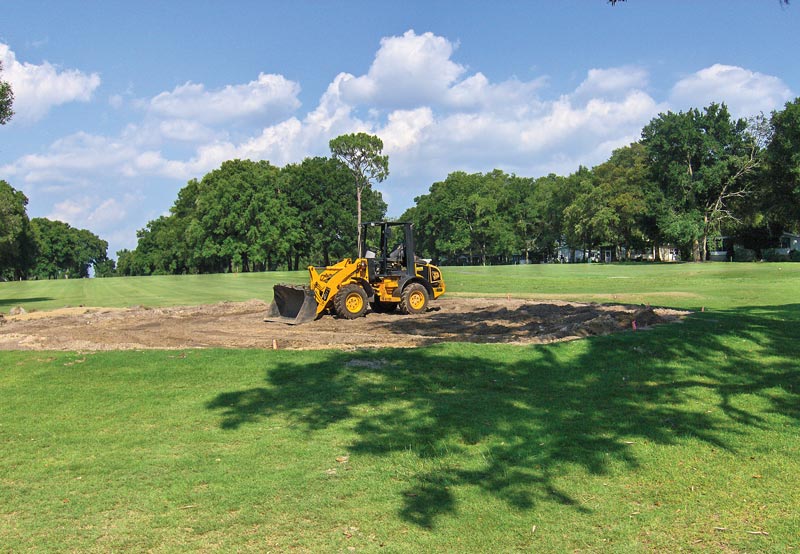
Work on the 15th hole at Water Oak Country Club in Lady Lake, Fla., was one of a number of green renovations completed in 2009 by course superintendent John Morrison. Photo by Jim Walsh
John Morrison doesn’t refer to himself as a renovation junkie. But if he carved a notch in his belt for every in-house project he’s done on a golf course, his pants would likely fall down. There’d be next to nothing left to hold them up.
“Off the top of my head, I’d say I’ve done at least 30. Gee, it might be as many as 50,” says Morrison, superintendent at Water Oak Country Club in Lady Lake, Fla., and a 13-year GCSAA member. “I wish I could spend the rest of my life just doing renovations ... then I wouldn’t have to grow grass or deal with people!”
Morrison laughs, of course, at that latter comment, but he’s almost serious about the former. Like most superintendents, he is an inveterate problem solver. Fixing things is almost part of the professional DNA, and whether it’s a single putting green or the entire back nine, all renovations involve initial destruction.
“Say a course has a crappy-looking green, and when they decide to rebuild it, the first move you make is to run a sod-cutter over it and it looks like a total mess,” he says. “Now it’s really ugly. Sometimes I say to myself, ‘I can’t believe they let me do this. I hope I can put it together again.’”
To date, across a 20-year career that includes time at Bay Hill, Isleworth and under Buck Buckner — “maybe the greatest superintendent who’s ever lived” — Morrison has managed to rejoin the dots every time. In recounting those experiences, he doesn’t specifically describe a “rush,” but he does touch on ingredients that are elemental to excitement. There’s challenge, pressure, uncertainty — all things that heighten anxiety as well as the degree of potential reward or payoff at the end.
“The owners put their faith, their money and their future profits in your hands, so you’re under pressure the whole time,” Morrison says. “But I’ve never had one that didn’t work out, and at the end of the day, they are so appreciative. You’ve just saved them a lot of money by not having to bring in contractors. You’re the hero when you’re done.”
Saddling up
But while every cowboy loves horses, it doesn’t mean they all ride rodeo.
Similarly, while many superintendents salivate at the prospect of driving a project that moves dirt and makes things better, not all want to saddle up on something that could ultimately break their neck. As Morrison points out, “I don’t think doing it yourself is necessarily the right thing for everybody.”
No one wants to end up in the outhouse because they kept the wrong project in-house.
“We have had to go in and fix renovations that superintendents have started,” says David Munkvold, president of the Golf Course Builders Association of America (GCBAA) and a vice president with Duininck Golf. “I don’t want to sound like I’m dead-set against the idea, but when I hear a golf course superintendent say they are doing an in-house renovation, I think, ‘Do you really understand the scope of your project? Do you have the resources available to tackle both construction and your first priority? Do you really have the time to devote to this?’”
The challenge for a facility and for the superintendent when determining whether to go out or to stay in is in balancing everybody’s aspirations with their resources and ability. It’s not always a simple equation. Some factors are hard to put into numbers.
There’s that matter of the superintendent’s DNA. As Munkvold observes, “There’s always a bit of excitement there on the part of the superintendent when it comes to the prospect of doing a little construction.” Owners, green committees and memberships can also get a gleam in their collective eye, get a little too ambitious and overreach, trying to extract silk from a cotton budget.
As Bill Anderson, CGCS, of Carmel Country Club in Charlotte, N.C., warns, “The fact you’re doing it in-house suggests there’s probably not that much slack in the rope.”
Sometimes a facility may have 10 items on its shopping list but can only afford five if it brings in contractors. Staying in-house may stretch the dollars enough to buy another two or three items, but if everyone’s not careful, they can be left with headaches the scale of which probably prompted the renovation in the first place.
Prepare everyone
“Really, it depends on the scope of the project and the capabilities of the superintendent,” Munkvold says. “Of course there are instances where the superintendent has done an excellent job in-house.” But even in those cases, Morrison suggests there are indirect costs to consider, though they don’t appear on most renovation budgets.
Progress will likely be slower because most facilities won’t have all the specialized equipment a contractor would bring in. Nor will the in-house operators match the expertise of those who do it for a living. Consequently, that means a longer downtime for whatever part of the course is being renovated and extending the interruption to both golfers and — critically —cash flow.
Then there’s the sheer volume of toil that Munkvold talked about.
“You’ve got to be prepared for a whole pile of work, man,” Morrison says. “Your family has to be prepared for that too. You are going to be there a lot. In a lot of cases you’ve still got a golf course to maintain, so you’ve got to consider who’s doing that work. You need an assistant who is very strong because your eyes will be off that ball.”

Golf course superintendent John Morrison has completed more than 30 in-house renovations. Photo by Doug Engel
Stress can also exact a price, although no one writes a check to cover it. Instead, the superintendent foots that bill with an internal physical currency that might show itself in sleepless nights, too much coffee or cigarettes and shorter fingernails.
“You’ve got the constant worry of cost overruns,” Morrison says. “And whether it’s a $20,000 job or a $100,000 job, those owners have their money staked in you. If it doesn’t work out or come out on time, it’s all your fault because you were the one who said you were going to get it done.”
That’s why Morrison says his single most important piece of advice for any superintendent considering an in-house renovation is simply this: “You’ve got to ask yourself what capabilities do you have, and be honest.”
No free ride
In Charlotte, Bill Anderson, a 37-year GCSAA member, is in the midst of a complete renovation of the club’s South Course, drawn by celebrated golf course architect Rees Jones. In his fourth decade at the club, one of the city’s premier facilities, Anderson has experienced about every possible aspect of the job, including countless in-house projects. So when he says taking a renovation out of the house is no free ride for a superintendent, it’s worth hearing why.
“You certainly get more horsepower when you go outside,” he says. “And if you pay that upfront fee, you’re going to have fewer worries, because that contractor has assured you they will get the work done. Still, it can be a nervous time. There’s a lot of work still necessary at the front end — planning, specifications, engineering. You’ve got to make sure it’s all locked down before they start so everybody knows what the goal is and what’s expected.”
Anderson says it took “all winter” to prepare specifications for his current project. But that time investment, he believes, will pay dividends for years to come.
“The most important step you can take toward getting the product you want is taking care of the specs,” he says. “If you want this kind of drainage, this particular grass source, tee shape, you need to say so. Do you want to use this sand vendor? These sod vendors? There was a lot of back and forth during that period with Rees Jones Inc., getting it all squared away. Then those specs became part of the contract.”
Even when that contract is signed and sealed and the contractors move in, Anderson says a superintendent can become consumed by the minutiae.
“It’s not so much anything major but rather a multitude of little decisions that have to be made from 6 a.m. until dark every day,” he says. “Do you want this drain over here or over there? Do you want golfers to leave this green here or there? None of these decisions are monumental but they are critical to the outcome, the performance of what you get in the end. Making the correct calls on that sort of thing can really affect quality and save you time and money once the job is done.”
Some peace of mind
Another step Anderson recommends is designating labor to measure what goes in the ground once the project begins. This, he says, provides considerable peace of mind for the superintendent, the facility and also the contractor.
“One of the challenging parts to get your head around is the concept of unit-price contracts,” Anderson says. “A lot of guys (superintendents) who haven’t done renovations or construction before haven’t encountered those. You just don’t build the golf course exactly as you plan it. Things always come up.”
Essentially, unit-price contracts are a means to better reflect the real cost of what goes into the end product. Contractors receive a fee that includes billing the facility per linear foot of irrigation line, the number of sprinkler heads, how many square feet of sod on the tees and so on.
“We spend a lot of time monitoring during the construction process, and that tracking gives you a level of comfort at the end of every month,” Anderson says. “We’ve got a couple of young guys measuring and we get together with the contractor before he submits his bill and make sure we’re on the same page.
“Smaller clubs who get rid of everybody when they head into a renovation,” he notes, “can be vulnerable to the contractor because then the contractor is left making all the decisions and doing all the counting.”

The 18th hole at Water Oak Country Club gets a facelift. Photo by Jim Walsh
Munkvold is aware of grapevine chatter that contractors add a premium to the materials they use. “Some people do fear a cost work-up on a product, but for most builders, that’s not something they do,” he says. Superintendents and facilities, he says, can limit exposure by engaging members of the GCBAA or American Society of Golf Course Architects, both of which, like GCSAA, perform their own kind of community policing on standards and ethics.
“Most builders don’t profess to do design work,” Munkvold says. “If a club is doing a redesign, new greens, tees, bunkers, cart paths, they’d be short-minded if they did not use somebody from the ASGCA. We’ve run into examples where club members have tried to do that role and it hasn’t turned out well. An architect comprehends the scope of a project. He is the one who can provide a master plan and understands if this is really what this facility needs.”
Ironically, the current economic climate, which has tightened the purse strings at most facilities and perhaps increased the incentive to look in-house, has simultaneously made superintendents more reluctant to put their hand up.
“We are running into less and less of the superintendent wanting to do it,” Munkvold says. “Superintendents are already cut down on budget and staff. They just don’t have a lot of guys standing around looking for something to do. They’re looking at in-house renovations and saying, ‘For what I’ve already got going, this adds too much.’ They don’t want to take the chance of getting it wrong or having it drag out an extra month or two.”
That may be true enough, but for the likes of John Morrison, it’s hard to beat the autonomy that an in-house project can provide. “You control what you are going to get to live with once it’s done,” he says, “and as a golf course superintendent, that’s pretty cool.”
Trent Bouts is a freelance writer based in Greer, S.C., and the editor of Carolina Greens, the official publication of the Carolinas GCSA.